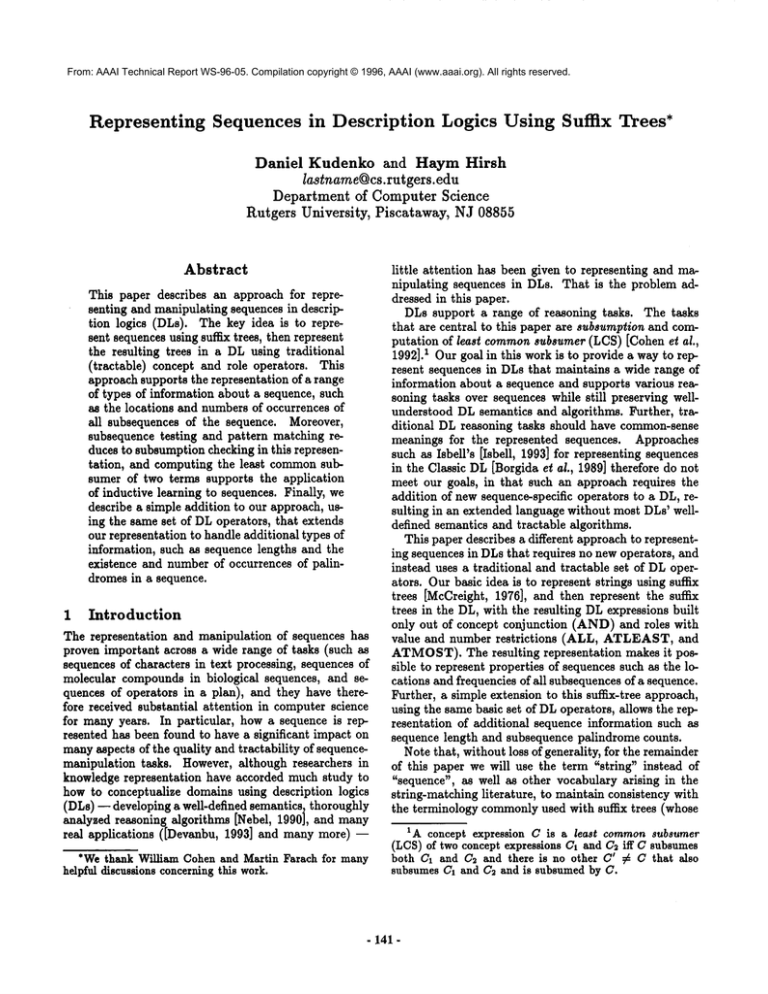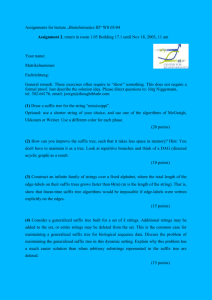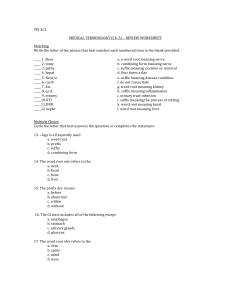
From: AAAI Technical Report WS-96-05. Compilation copyright © 1996, AAAI (www.aaai.org). All rights reserved.
Representing
Sequences in Description
Logics Using Suffix
Trees*
Daniel
Kudenko and Haym Hirsh
lastname@cs.rut gers. ed u
Department of Computer Science
Rutgers University, Piscataway, NJ 08855
Abstract
This paper describes an approach for representing and manipulatingsequences in description logics (DLs). The key idea is to represent sequencesusing suffix trees, then represent
the resulting trees in a DLusing traditional
(tractable) concept and role operators. This
approachsupports the representation of a range
of types of information about a sequence, such
as the locations and numbersof occurrences of
all subsequences of the sequence. Moreover,
subsequencetesting and pattern matchingreduces to subsumptioncheckingin this representation, and computingthe least commonsubsumer of two terms supports the application
of inductive learning to sequences. Finally, we
describe a simple addition to our approach,using the sameset of DLoperators, that extends
our representation to handleadditional types of
information, such as sequencelengths and the
existence and numberof occurrences of palindromesin a sequence.
1 Introduction
The representation and manipulation of sequences has
proven important across a wide range of tasks (such as
sequencesof characters in text processing, sequencesof
molecular compoundsin biological sequences, and sequences of operators in a plan), and they have therefore received substantial attention in computerscience
for manyyears. In particular, howa sequence is represented has been found to have a significant impact on
manyaspects of the quality and tractability of sequencemanipulation tasks. However,although researchers in
knowledgerepresentation have accorded muchstudy to
howto conceptualize domainsusing description logics
(DLs) -- developinga weU-definedsemantics, thoroughly
analyzed reasoning algorithms [Nebel, 1990], and many
real applications ([Devanbu, 1993] and manymore)
*Wethank WilliamCohenand Martin Farach for many
helpful discussionsconcerningthis work.
little attention has been given to representing and manipulating sequences in DLs. That is the problem addressed in this paper.
DLssupport a range of reasoning tasks. The tasks
that are central to this paper are s~bsump~ion
and computation of leas~ commonsubs~mer(LCS)[Cohenet al.,
1992].1 Ourgoal in this workis to provide a wayto represent sequences in DLsthat maintains a wide range of
information about a sequence and supports various reasoning tasks over sequenceswhile still preserving wellunderstood DLsemantics and algorithms. Further, traditional DLreasoning tasks should have common-sense
meanings for the represented sequences. Approaches
such as Isbell’s [Isbell, 1993]for representing sequences
in the Classic DL[Borgidaet al., 1989]therefore do not
meet our goals, in that such an approach requires the
addition of newsequence-specific operators to a DL, resuiting in an extendedlanguagewithout most DLs’welldefined semantics and tractable algorithms.
This paper describes a different approachto representing sequencesin DLsthat requires no newoperators, and
instead uses a traditional and tractable set of DLoperators. Ourbasic idea is to represent strings using suffix
trees [McCreight,1976], and then represent the suffix
trees in the DL, with the resulting DLexpressions built
only out of concept conjunction (AND)and roles with
value and number restrictions
(ALL, ATLEAST,
and
ATMOST).
The resulting representation makes it possible to represent properties of sequencessuch as the locations and frequenciesof all subsequences
of a sequence.
Further, a simple extensionto this suffix-tree approach,
using the samebasic set of DLoperators, allows the representation of additional sequence information such as
sequence length and subsequencepalindrome counts.
Notethat, withoutloss of generality, for the remainder
of this paper we will use the term "string" instead of
"sequence", as well as other vocabulary arising in the
string-matchingliterature, to maintain consistency with
the terminologycommonly
used with suffix trees (whose
1A concept expression C is a least commonsubsumer
(LCS)of twoconceptexpressions(71 and(72 iff C subsumes
both C1and C2 and there is no other C’ ~ C that also
subsumesC1and C2 and is subsumedby C.
- 141-
B
,,O
Figure 2: Exampleof a tree that corresponds to no string
Figure 1: Suffix tree for the string "ACCB"
origins come from the theory of string matching).
2
Representing
Suffix Trees
Strings
in DLs Using
Our approach to representing strings in DLs uses a data
structure developed in the string matching literature
knownas "suffix trees". This section first describes suffix trees, then shows how they can be represented and
manipulated in DLs.
2.1
Suffix Trees
Givena string S over an alphabet ~, a suffix tree for S is
the unique tree with the following properties: 2 (1) each
edge is labeled with a single character from ~ (and a path
is labeled with the sequence of the characters labeling the
edges along the path); (2) no two outgoing edges from
a single node are labeled with the same character; (3)
each path from the root to a leaf is labeled with a suffix
of S; and (4) for each suffix of S there is a corresponding
path from the root to a leaf.
For example, the suffix tree for the string "ACCB"
(over the three-letter alphabet {A, B, C), which for exposition reasons serves as the alphabet for all examples
in this paper) is given in Figure 1. Every suffix of the
string corresponds to a path from the root of the tree
to some leaf, and each path from the root to some leaf
corresponds to a sufiLx of the string.
The suffix tree for a string S of length ISI can be computed rather simply, in time fl(ISi~).
2.2
Representing
Suffix Trees in DLs
Representing a suffix tree in a DL is fairly straightforward, given that the "topology" of a concept expression using roles is already often depicted in tree form.
The task is simply to generate the appropriate expression whosetree is identical to the given suffix tree. The
leaves of the tree are represented by a primitive concept,
NODE,that is introduced solely for this purpose.
To do so, we create a role for every element of the
string’s alphabet ~. The algorithm computes an expression arising from each successor of the root of the tree
2Notethat ourdefinition of suffix trees differs fromthat
used in manystring matchingalgorithms, in that rather than
collapsing into a single edgeeachpath all of whosenodeshave
single successors, weleave such paths intact to permit encoding a wider range of informationthan is typically represented
with suiBx trees. This will be clear once the representation
extensions axe presented.
and conjoins them together. Thus, for example, the DL
definition corresponding to the suffix tree from Figure 1
is the following.
(and (allA (allC (allC (allB NODE))))
(allC (and(allC (allB NODE))
(allB NODE)))
(allB NODE))
Importantly,
theDL subsumption
relation
hasa practicaluse for reasoning about strings. If ST(S) is the
suffix tree for string S, and DL(T)is the DLexpression
for a suffix tree T, the following is true:
Lemma1 If $1 and $2 are strings, ~hen S1 is a subs~ring of $2 iff DI(ST(S2)) E_ D£(ST(S1)).
In other words, subsumption checking of the DL expressions generated from two strings is equivalent to substring testing. The proof of this lemma follows from
the fact that DL(ST(S1)) subsumes DL(ST(S2))
paths in the first appear in the second. Since every path
from the root to an internal node of a suffix tree ST(S)
corresponds to a substring of S, the set of all paths in
DL(ST(S1))is a subset of those in DL(ST(S2))if[
a substring of $2.
3
Pattern Matching Using Suffix
Trees
The previous section showedthat suffix trees can be used
to represent strings. But what about trees that are labeled with characters yet do not correspond to strings,
such as the tree in Figure 2? In this section we present a
semantics for such trees that lets us go beyond substring
checking to handle a range of forms of pattern matching.
3.1
Simple Pattern
Matching
A suffix tree can be thought of as a data structure that
maintains all substrings of a string -- each path from
the root to some node corresponds to a substring of the
string. To enable pattern matching with suffix trees we
associate an interpretation to any tree whose edges are
labeled with characters (we call these trees pa~ern ~rees):
a pattern tree denotes the set of all strings that contain
all substrings that correspond to paths from the root to a
node. More formally, each pattern tree T for an alphabet
is interpreted as a set of strings in the following way:
where L(v) is the label of the path from the root to the
node v (L(roat) is by definition the empty string) and
- 142-
¯
A
"O
6
"O
C
B
,’O
C
PO
-
S’
¯
C ,,,O
.O
Figure 4: A pattern tree with substring frequencies
Figure 3: A pattern tree and its normalized version
N(T) is the set of nodes in T. Thus, for example, the
tree shownin Figure 2 is interpreted as the set of strings
containing the substrings "CB’, "AC", and "B’. Note
that the suffix tree for a string is a special case of a
pattern tree, wherethe interpretation of a suffix tree for
a string S is the set of strings ~]*SI]*, i.e., all strings
that contain S as a substring.
Pattern trees makeit possible to test whether a string
contains some desired collection of strings. Given some
set of strings, it is straight-forward to create a pattern
tree that contains all the desired strings, with the DL
suffi-tree creation algorithm still applying to such generated trees. Thus, for example, the pattern tree in Figure 2 is represented by the DLexpression
(and (all C (all B NODE))
(allA (aliC NODE))
Call S NODE))
As with Lemma1, it is possible to state formally
the relationship between the strings matched by a pattern and the subsumption relation applied to their corresponding DLrepresentations. In order to do this, pattern trees have to be normalized in the following way.
Makesure that for each path from a node to a leaf there
is a path with the same labels from the root to a leaf.
The resulting normalized pattern tree denotes the same
set of strings as the original tree. Figure 3 contains an
example for this normalization.
Let Norm(T)be the normalized version of the pattern
tree T. Then the following lemma holds:
Lemma2 If T1 and T2 are pattern trees, then T~ C T~
i~ DI,(Norm(T1))
C_ DL((Norm(T2)).
In other words, the lemmastates that subset relationships amongst sets of strings denoted by pattern trees
are equivalent to subsumption relationships amongthe
corresponding DLexpressions.
The previous section showedhowthe suffix-tree string
representation reduces substring testing to subsumption
checking. Note that despite the semantics of a suffix tree
nowdenoting a set of strings, this property still holds:
Corollary
1 If $1 and $2 are strings,
then
DL(ST(SI))
C_ DL(ST(S2))
iffsubstr in g o/ $i.
Theproofof thiscorollary
follows
fromthefactthat
~,*S1F,*C_ F,*S2~,*iff $Iis a substring of $2.
Our final corollary shows the usefulness of pattern
trees for pattern matching, namely that if a pattern tree
T matches some string S then the proper relationship
holds between their DLrepresentations:
Corollary 2 If S is a string and T is a pattern tree,
then DL(ST(S)) E_ DL(T) iff path
s in Y arela bele d
by substrings of S.
Finally, we note that these semantics for pattern trees
also makes the LCS operator have intuitively
appealing meaning. If T1 and T2 are pattern trees, then the
pattern tree corresponding to the LCS of DL(T1) and
DL(T2) subsumes the DL expressions for exactly those
strings that contain all the strings corresponding to the
paths contained in both T1 and T2. For example, the
pattern tree in Figure 2 corresponds to the LCSof the
DLexpressions for the suffix trees of the strings "ACBC"
and "CBAC’. Because of this, LCS can be used to perform inductive learning over strings. Indeed, our original
motivation for this work was to find a way to represent
strings in DLs so that existing DL learning approaches
can be applied [Cohen and Hirsh, 1994].
3.2
Pattern Matching with Substring
Counts
A simple pattern tree as presented in the previous section
contains only information about the existence of patterns
(i.e., substrings), but not on how often they can occur
in a string. The representation of a pattern tree can be
extended to encode such information by labeling edges
with the minimumnumber of times a certain pattern
may occur in a string. To be more precise, each edge e
in the tree nowcarries a number that restricts the number of minimumoccurrences of L(target(e)), the string
that labels the path from root to target(e). The pattern
tree in Figure 4, for example, matches all strings with at
least two "A", and at least one "C", one "B’, one "CB",
and one "AC" -- number restrictions
are displayed below the respective edge. It is straight-forward to extend
the suffix-tree creation algorithm to handle such stringfrequency counts, with the time and space complexity
remaining quadratic in the length of the string.
The denotational semantics for pattern trees have to
be modified for this extended pattern-matching language.
The interpretation of a tree T is nowthe set of strings
r,-:_- N
~eJV(T)
where Fmi,(v) is the minimumnumber restriction on the
incoming edge of node v. Intuitively the interpretation
- 143-
(and(allA (and(allC (and(allA (and(allC (atleas~I min-occ~s))
(atleast I mln-occurs)))
(atleast 2 min-occurs)))
(atleast 2 min-occurs)))
(all C (and (all A (and (all C (atleast I min-occurs))
(a%least 1 min-occurs)))
(atleas% 2 min-occurs))))
Figure 5: DLexpression for the suffix tree for "ACAC"
defines the set of all strings that contain I(v) at least
F,,i, (,~) times.
Representing such extended pattern trees in DLs is
straightforward
by using a new role rain-occurs. To
represent the F,,i, value of some pattern-tree edge e we
add an ~(atleast Fmi,(e) rain-occurs)" restriction
the node in the DL expression that corresponds to the
destination of e. Figure 5 gives the DLdefinition that
results for the string "ACAC’.It contains, for example,
the information that "AC"occurs at least 2 times.
Weconclude this section by noting that Lemma2 and
its corollaries still hold, i.e., subsumptionstill computes
pattern matching and does substring testing. Further,
the LCSof the DLdefinitions for two pattern trees keeps
its meaning, representing the intersection of the two sets
of strings described by the pattern trees.
3.3
Pattern Matching
Locations
with
Substring
In cases when the position of these substrings is of importance, suffix trees can be extended with positional
information. This can be done in a fashion analogous
to that of the previous section, with each edge e having
two new integer labels, one for the ending location of
the first occurrence of L(target(e)) and a second for
last occurrence. Figure 6 shows the pattern tree that is
generated for the string "ACBAC’.This tree contains,
for example, the information that the first occurrence of
"AC" ends at position 2 and the last ends at position
5 in the string "ACBAC’.It is again straight-forward
to modify the pattern-tree creation algorithm so that
it creates pattern trees with positional information and
maintains its quadratic computational complexity.
The semantics of suffix trees with positional informaC .e
(5,@
tion can be defined as follows:
TIP :--
where P,.i.(v)
and Pmax(v) are the first and last positions in a string where L(v) may begin.
Pattern trees can be represented in DLs using a similar approach to the one used with substring counts. We
use one additional role, position. Each P,,i, value on
an edge e addsan "(atleast
Pmin(e) position)"
restriction to the node in the DL expression that corresponds to the destination of e, and each Pmax value
adds an "(atmost Pmax(e) position)" restriction.
nally, note that although Lemma2 and Corollary 2 still
hold for pattern trees with positional information, Corollary 1 does not. In other words, subsumption still implements pattern matching, but no longer supports substring checking. The LCSof two DL pattern trees, on
the other hand, still computesthe intersection of the substrings in the two pattern trees, unioning the interval of
locations for each resulting string.
Combining Frequency
and Positional
Information
Weend this section by noting that the two extended
forms of pattern matching based on suffix trees presented
in this section are not mutually exclusive. The conjunction of the DL definitions generated from a string by
each approach would give the suffix tree that carries
both positional and pattern frequency information. In
the resulting tree an edge has three numbers attached
to it. Note that each extension can be independently
used or ignored, depending on the application domain.
The semantics for pattern trees with such combined positionai and frequency information can be easily derived
from the semantics of the individual constructs, by forming the intersection of the two sets of strings defined
by the trees for positional and frequency information:
TIc°~b:= TIF n TIP.
3.4
4
Figure 6: Suffix tree with positional
"ACBAC"
information for
Representing
Other String
Properties
In addition to representing information about the desired substrings that should appear in a string and various properties of these substrings, it is often desirable to
associate properties with an overall string. For example,
one might want to reason about the length of a string,
- 144-
the number of palindromes that it contains, or "extrinsic" information about the string (the author of some
text, the functional role of a DNAsequence, etc.).
Such information can be easily added to the patterntree representation of the previous section. Each such
property adds a new edge to the root of the tree labeled
with the name of that property (length, palindromecount, author, functional-role, etc.). Whenthe value of
the property is an integer the information can be stored
as a number restriction
in a manner analogous to how
string counts or locations were handled in the previous
section. To handle other, non-numeric-valued properties, each possible value must be defined as a concept
and the information can be attached to the DLpattern
tree by labeling the target node of the edge leaving the
root with that property name. For example, the following is the DLexpression for a tree with a hypothetical
DNAlabel:
(and(allC (and(allC (allA (allA NODE)))
(allA (all A NODE))))
(allA (allA NODE))
(allContex~PRONOTER-XY))
5
Final
Remarks
This paper has proposed a representation
formalism,
based on the suffix-tree data structure, to represent and
reason about sequences in description logics. Strings and
patterns on strings are represented as a form of suffix
trees, with the trees in turn represented as DLexpressions. Using this representation subsumptlon supports
substring checking as well as a (modular) range of forms
of pattern matching. Wealso described a simple extension to this representation that allows representing
global properties of a string.
A numberof interesting issues still remain. The first
is the question of broadening the class of patterns than
can be represented in this suffix-tree-based formalism by,
for example, introducing meta-characters such as the "*"
character to denote a "don’t care" position in a string.
One obvious candidate for doing so is through the use
of role hierarchies, although this can result in exponentially large normalized DL representations [Hollunder
and Nutt, 1990]. A second issue is the question of using this representation to learn from sequences. Indeed,
this work was originally motivated by our attempt to apply DL learning algorithms based on the LCSoperation
[Cohen and Hirsh, 1994] to sequences, and developing
noise-tolerant methodssuited to such tasks is a topic for
future research.
experimental results. In Principles of knowledge rep.
resenta~ion and reasoning : proceedings of ~he ~hird
international conference (KR ’gY~), 1994.
[Cohen e~ al., 1992] W.
Cohen,
A.
Borgida,
and H. Hirsh. Computing least commonsubsumers
in description logics. In Proceedings of ~he Tenth National Conferenceon Ar~iJ~eial Intelligence, 1992.
[Devanbu, 1993] Prem Devanbu. Translating description logics into information server queries. In Second
International Conference on Information and Knowledge Management, 1993.
[Hollunder and Nutt, 1990] B. Hollunder and W. Nutt.
Subsumption algorithms for concept languages. Technical Report RR-90-04, DFKI, 1990.
[Isbell, 1993] C.L. Isbell. Sequenced classic. Research
Note, AT&TBell Laboratories, 1993.
[McCreight, 1976] E.M. McCreight. A space economical
suffix tree construction algorithm. J. Assoc. Comput
Mach, 23:262-272, 1976.
[Nebel, 1990] Bernhard Nebel. Reasoning and ,’evision
in h~/brid represen~aZion s~/s~ems. Springer-Verlag,
Berlin, 1990.
References
[Borgida e~ al., 1989] A. Borgida, R.J. Brachman, D.L.
McGuinness, and L.Resnick. Classic: A structural
data model for objects. In Proceedings of SIGMOD89, 1989.
[Cohen andHirsh, 1994] W. Cohen and H. Hirsh.
Learning the classic description logic: Theoretical and
- 145-






